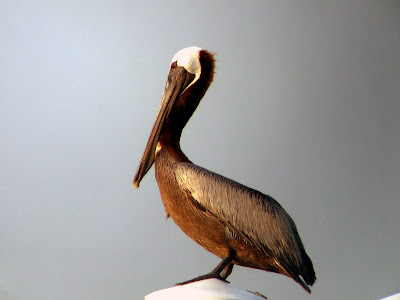
Fort DeSoto is an amazing site, with lovely beaches and great birding. Here there were numerous heron species on offer which were very tame, as well as various species of waders, terns and magnificant frigatebirds.

.JPG)
.JPG)


.JPG)
.JPG)

I'm starting to get the hang of the birding out here now, with my eye at least semi trained in. The drive to and fro was fantastic, with a total of six swallow tailed kites seen, several red tailed and red shouldered hawks, wild turkey, wood stork, numerous species of egrets and herons and many other species seen.
When in the Hollywood/Fort Lauderdale area, a visit to West Lake Park offered the opportunity to photograph some approachable cattle egrets, snowy egrets and white ibis. However, due to time constraints little else was seen here. Of note in the this area was the abundance of iguanas and various other inntroduced/escaped reptiles.
 Cattle Egret
Cattle Egret Grasshopper sp
Grasshopper sp Green Iguana
Green Iguana Basilisk
Basilisk



 White-winged dove
White-winged dove Alligator
Alligator Great blue heron
Great blue heron Red-bellied woodpecker
Red-bellied woodpecker Red cardinal
Red cardinal Anhinga
Anhinga
 Lettuce Lake Board-Walk
Lettuce Lake Board-Walk
Day 1 (9th June), I payed a quick visit to Lettuce Lake Park. This is an excellent site with a boardwalk stretching 3,500 feet through forestry and marshland. It hosts numerous breeding birds such as summer tanagers, prothonotary warblers, red eyed vireos, swallow tailed kites, osprey, etc. I didn't get to spend much time here this day, as there was a fairly bad thunder storm looming. However, I did get to see a pair of swallow tailed kites, many ospreys, singing parulas and a pair of downy woodpeckers. Below is a picture of a very confiding osprey at the site.
 Osprey
Osprey
Loggerhead Shrike

American Oystercatcher

Yellow-Crowned Night Heron
Day 2 (10th June), I took another visit to lettuce lake park where I saw a green heron and had several singing red eyed vireos, red cardinals, parulas etc. I also saw my first wild alligator here. On the way I saw a pair of swallow tailed kites, two dark morph short tailed hawks as well as a light morph. I also took a visit to the dog beach again where I took a number of pictures of confiding birds.

Green Heron

Mourning Dove

Brown Pelican
Boat-Tailed Grackle

Laughing Gull




 Between August and September there is an incredible opportunity to witness immigration of mediterranean gulls, with my maximum count standing in the 40's. During this period it's possible to see double figures of juvenile med' gulls, which in my opinion look very smart upon arrival from their place(s) of birth.
Between August and September there is an incredible opportunity to witness immigration of mediterranean gulls, with my maximum count standing in the 40's. During this period it's possible to see double figures of juvenile med' gulls, which in my opinion look very smart upon arrival from their place(s) of birth.
By far, my most memorable day's birding took place last year, on the 13th of September. It was a flat calm, warm day. Myself and my father decided it was a perfect day for the sea, and we were by no means dissapointed. The day started out at the Irish Naval Base, located on Haulbowline island, where my father keeps the boat tied up.


 After seeing how slack the birding was close to the harbour, we decided to head far offshore (or as far as a sailboat could take us). We ended up motoring 8 nautical miles offshore, where we decided to switch off the engine and let the boat drift. We had no chum with us that day, as my dad is slightly obsessed with the cleanliness of his boat (just messing dad!:P) Well, we decided to have some lunch and at least relax and observe what we could in the unusually calm conditions. I must admit my alertness in terms of birding eased right off and I just sat there eating and taking in the scenery. That was until my dad asked me "Seán ,what's that weird looking gull with the black wedges behind you called?". I shot around to look behind me and see a lovely first winter sabine's gull, hovering with curiosity, over the boat. Fantastic! The bird hung around for no more than ten seconds before continuing West.
After seeing how slack the birding was close to the harbour, we decided to head far offshore (or as far as a sailboat could take us). We ended up motoring 8 nautical miles offshore, where we decided to switch off the engine and let the boat drift. We had no chum with us that day, as my dad is slightly obsessed with the cleanliness of his boat (just messing dad!:P) Well, we decided to have some lunch and at least relax and observe what we could in the unusually calm conditions. I must admit my alertness in terms of birding eased right off and I just sat there eating and taking in the scenery. That was until my dad asked me "Seán ,what's that weird looking gull with the black wedges behind you called?". I shot around to look behind me and see a lovely first winter sabine's gull, hovering with curiosity, over the boat. Fantastic! The bird hung around for no more than ten seconds before continuing West.

 At this distance, there were no small gulls present - not even kittiwakes. So, when I saw a small gull in the distance flying toward me, I was on the job again. I stayed on it until it came close enough to be identified as our second first-winter sabine's gull of the day! What was extra pleasing with this bird was the fact that it dropped down on the water to feed! We started up the engine and slowly motored towards it, keeping an eye on the location on the way. It soon became apparent that there were other birds sitting on the water with it. What were they!? They were small and distant - maybe more sabine's gulls? It soon became apparent that they were some kind of wader, and of course turned out to consist of 7 grey phalaropes! I couldn't believe my luck. We ended up getting fantastic views down to feet of what turned out to be incredibly tame and confiding birds! It was fantastic to listen to the phalaropes call to each other while they fed and spun on the water. Here are a few pictures to give ye an idea of just how confiding and special these birds were:
At this distance, there were no small gulls present - not even kittiwakes. So, when I saw a small gull in the distance flying toward me, I was on the job again. I stayed on it until it came close enough to be identified as our second first-winter sabine's gull of the day! What was extra pleasing with this bird was the fact that it dropped down on the water to feed! We started up the engine and slowly motored towards it, keeping an eye on the location on the way. It soon became apparent that there were other birds sitting on the water with it. What were they!? They were small and distant - maybe more sabine's gulls? It soon became apparent that they were some kind of wader, and of course turned out to consist of 7 grey phalaropes! I couldn't believe my luck. We ended up getting fantastic views down to feet of what turned out to be incredibly tame and confiding birds! It was fantastic to listen to the phalaropes call to each other while they fed and spun on the water. Here are a few pictures to give ye an idea of just how confiding and special these birds were: One of seven grey phalaropes which would fly TOWARDS the boat if you stayed still.
One of seven grey phalaropes which would fly TOWARDS the boat if you stayed still. This first winter sabine's gull was easily bird of they day for me
This first winter sabine's gull was easily bird of they day for me


